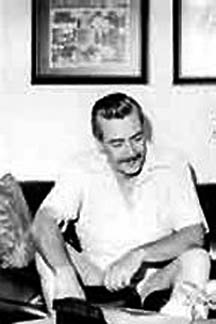
Alexander Toth was an American cartoonist active from the 1940s through the 1980s. Toth's work began in the American comic book industry, but he is also known for his animation designs for Hanna-Barbera throughout the 1960s and 1970s. His work included Super Friends, Fantastic Four, Space Ghost, Sealab 2020, The Herculoids and Birdman. Toth's work has been resurrected in the late-night, adult-themed spin-offs on Cartoon Network’s late night sister channel Adult Swim: Space Ghost Coast to Coast, Sealab 2021 and Harvey Birdman, Attorney at Law.

Scorchy Smith is an American adventure comic strip created by artist John Terry that ran from March 17, 1930 to December 30, 1961.

Comics Revue is a bi-monthly small press comic book published by Manuscript Press and edited by Rick Norwood. Don Markstein edited the publication from 1984 to 1987 and 1992 to 1996.
United Feature Syndicate, Inc. (UFS) is a large American editorial column and comic strip newspaper syndication service based in the United States and established in 1919. Originally part of E. W. Scripps Company, it was part of United Media from 1978 to 2011, and is now a division of Andrews McMeel Syndication. United Features has syndicated many notable comic strips, including Peanuts, Garfield, Li'l Abner, Dilbert, Nancy, and Marmaduke.

Vision (Aarkus) is a superhero appearing in American comic books published by Marvel Comics. Created by the writer Joe Simon and artist Jack Kirby, the character first appeared during the Golden Age of comic books in Marvel Mystery Comics #13, published by Marvel predecessor Timely Comics.

Casey Ruggles is a Western comic strip written and drawn by Warren Tufts that ran from May 22, 1949, to October 30, 1955.

Chester Warren Tufts, best known as Warren Tufts, was an American comic strip and comic book artist-writer best known for his syndicated Western adventure strip Casey Ruggles, which ran from 1949 to 1954.

The Funnies is the name of two American publications from Dell Publishing, the first of these a seminal 1920s precursor of comic books, and the second a standard 1930s comic book.

More Fun Comics, originally titled New Fun: The Big Comic Magazine, is a 1935–1947 American comic book anthology that introduced several major superhero characters and was the first American comic book series to feature solely original material rather than reprints of newspaper comic strips. It was also the first publication of National Allied Publications, the company that would become DC Comics.

Latigo was a comic strip written and drawn by cartoonist Stan Lynde, who also created the Rick O'Shay comic strip. After a dispute over the ownership of Rick O'Shay with the Chicago Tribune Syndicate, Lynde left and went to Field Enterprises to launch Latigo.

Leading Comics is a 1942–1955 comic book published by what is now DC Comics during the 1940s and early 1950s, a period known to fans and historians as the Golden Age of Comic Books.

Korak, a fictional character, is the ape name of John "Jack" Clayton III, the son of Tarzan and Jane Porter.

The Heart of Juliet Jones is an American comic strip series created by Elliott Caplin and drawn by Stan Drake, beginning on March 9, 1953. The strip was distributed by King Features Syndicate.
Star Hawks was a comic strip created by Ron Goulart and Gil Kane, first published on October 3, 1977, that ran through May 2, 1981. It was written through April 1979 by Goulart, followed by Archie Goodwin (1979-1980), Roger McKenzie (1980-1981) and Roger Stern. Comics veteran Gil Kane provided the artwork, with uncredited help from Ernie Colón and Howard Chaykin.
Baron Bean is a newspaper comic strip created by the cartoonist George Herriman. Baron Bean was distributed by King Features Syndicate.

Crack Comics is an anthology comic book series published by Quality Comics during the Golden Age of Comic Books. It featured such characters as The Clock, Black Condor, Captain Triumph, Alias the Spider, Madame Fatal, Jane Arden, Molly the Model, and Red Torpedo. The title "crack" referred to "being at the top of one's form", like a "crack sharpshooter".
Ruben Moreira was a Puerto Rican comic book artist and writer best known for his work on Tarzan and as a DC Comics artist.

Room and Board is the title of two American comic strips. The first, created by Sals Bostwick, debuted on May 21, 1928. He drew it until his death in 1930, after which it was continued by cartoonists Brandon Walsh, Benbee, Darrell McClure, Dow Walling and Herman Thomas before coming to an end in 1932.

Western comics is a comics genre usually depicting the American Old West frontier and typically set during the late nineteenth century. The term is generally associated with an American comic books genre published from the late 1940s through the 1950s. Western comics of the period typically featured dramatic scripts about cowboys, gunfighters, lawmen, bounty hunters, outlaws, and Native Americans. Accompanying artwork depicted a rural America populated with such iconic images as guns, cowboy hats, vests, horses, saloons, ranches, and deserts, contemporaneous with the setting.
Associated Newspapers, Inc. was a print syndication service of columns and comic strips that was in operation from 1912 to c. 1966. The syndicate was originally a cooperative of four newspapers: The New York Globe, the Chicago Daily News, The Boston Globe, and the Philadelphia Bulletin. Associated Newspapers was led by Henry Herbert McClure (1874-1938), a cousin of S. S. McClure, founder of the McClure Syndicate, the first American newspaper syndicate. In 1930, Associated Newspapers was acquired by and became a subsidiary of the Bell Syndicate. The syndicate's most successful, long-running strip was Gladys Parker's Mopsy.















